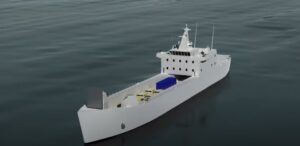SAN DIEGO– A top Marine Corps official here this week dismissed concerns the services new Medium Landing Ships (LSM), formerly called the Light Amphibious Warship (LAW), are not survivable enough, arguing there is always a balance.
“Survivability is a discussion that I have all the time. Survivability is not binary. It’s not black or white, yes or no, zero or one. Things are made more survivable when you add resources to make their movements more secure. Nothing in and of itself is ‘survivable,’” Gen. Eric Smith, Assistant Commandant of the Marine Corps (ACMC), said here Wednesday during the annual WEST conference, sponsored by AFCEA International and the U.S. Naval Institute.

The LSM/LAW is planned to move the Marine Littoral Regiment (MLR), with a focus on operations and capabilities in Western Pacific region islands, particularly focused on trying to deter China in any potential conflict.
Smith downplayed amphibious vessel survivability concerns by comparing it to the rest of the military.
Well, if I take that to the next step, soldiers and Marines y’all can’t leave the barracks because the enemy’s got machine guns. Hey, pilots, you got to stay on the tarmac because there’s anti-air missiles out there. Hey, submariners and ship drivers, y’all can’t leave the pier because there’s [anti-ship cruise missiles] and torpedoes. That doesn’t make sense.”
Smith said the Marine Corps is part of the fleet and if the fleet commander decides the “high-value package of the assets” the MLR is expected to field is worthwhile, that “they need to move from point A to point B, the fleet commander…will apply resources to get that package where it needs to go,” whether that involves destroyer escorts, deception, or other methods.
The MLR will field systems like the Navy-Marine Corps Expeditionary Ship Interdiction System (NMESIS), JLTV-based ROGUE Fires, and Ground/Air Task-Oriented Radars (G/ATOR).
Last year, Tom Rivers, the Executive Director for Amphibious, Auxiliary and Sealift at Program Executive Office Ships, said while the service is aiming to keep the Light Amphibious Warship/Medium Landing Ship concept under $150 million each, that limit could be tossed away based on requirements, including survivability concerns.

“We’re trying to buy the ship within the budget, but we’re also looking at what are the range of possibilities for different types of technologies, different survivability…aspects, what does that cost, how does that get into design and we’re doing tradeoffs in terms of capability for requirements,” Rivers said.
He said at the end of the day, if the service determined the capability requirements are needed no matter the cost, the budget will ultimately be adjusted to the requirements.
The Navy’s fiscal year 2023 budget request documents said the first LSM is expected to be procured in FY ‘25 for $247 million, the second vessel for $203 million in FY ‘26, and the third and fourth vessels in FY ‘27 for $145 million each. Costs associated with the first LSM will include most of the detailed design and nonrecurring engineering expenses of the entire class.
The first LSM is expected to be awarded in late 2024 and be delivered in July 2028.
According to a December Congressional Research Service report, the LSM/LAW ships are expected to have survivability tied to their ability to hide among islands and sea traffic, other naval vessels, and the ability of their MLR units to fire missiles at threatening Chinese ships and aircraft.